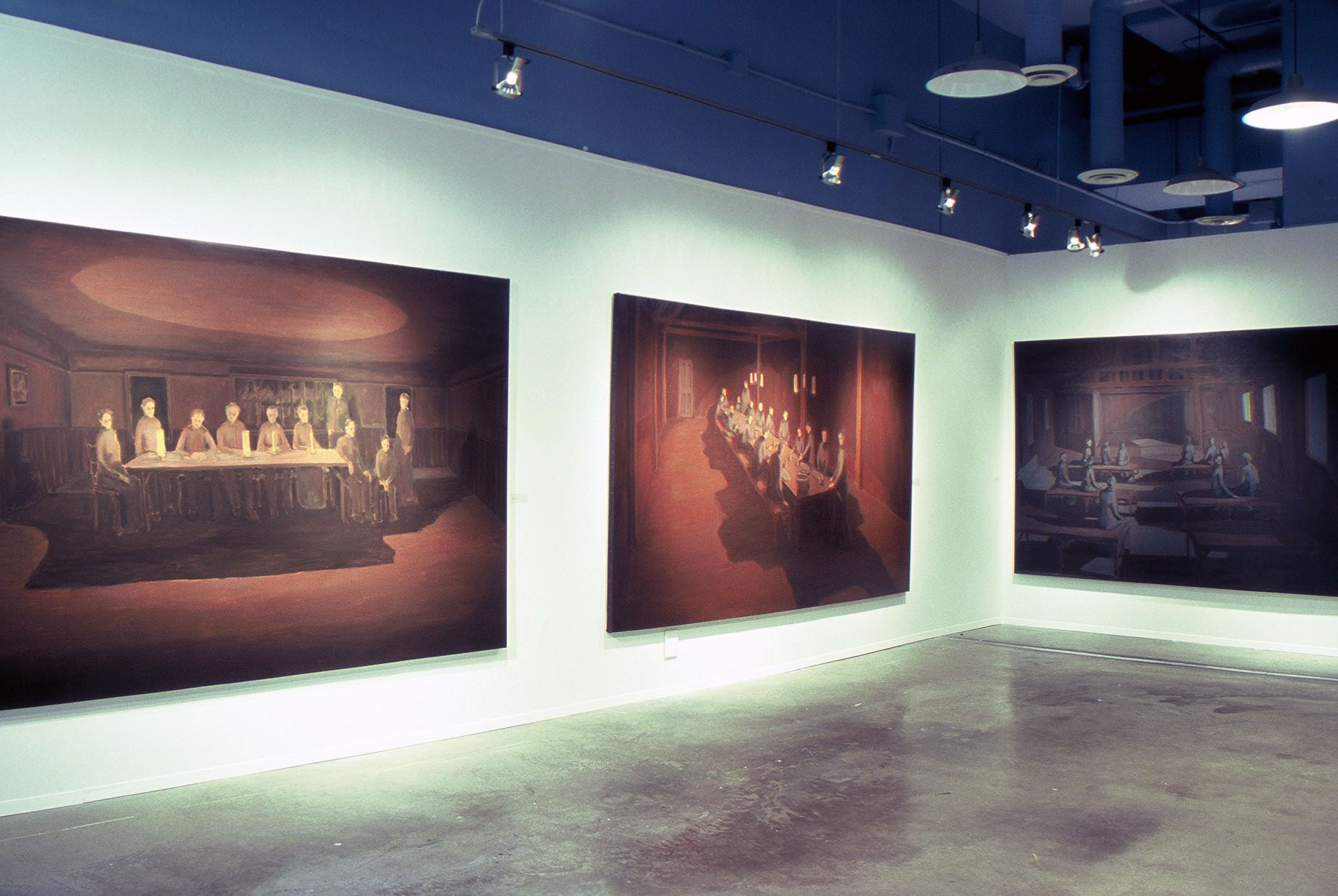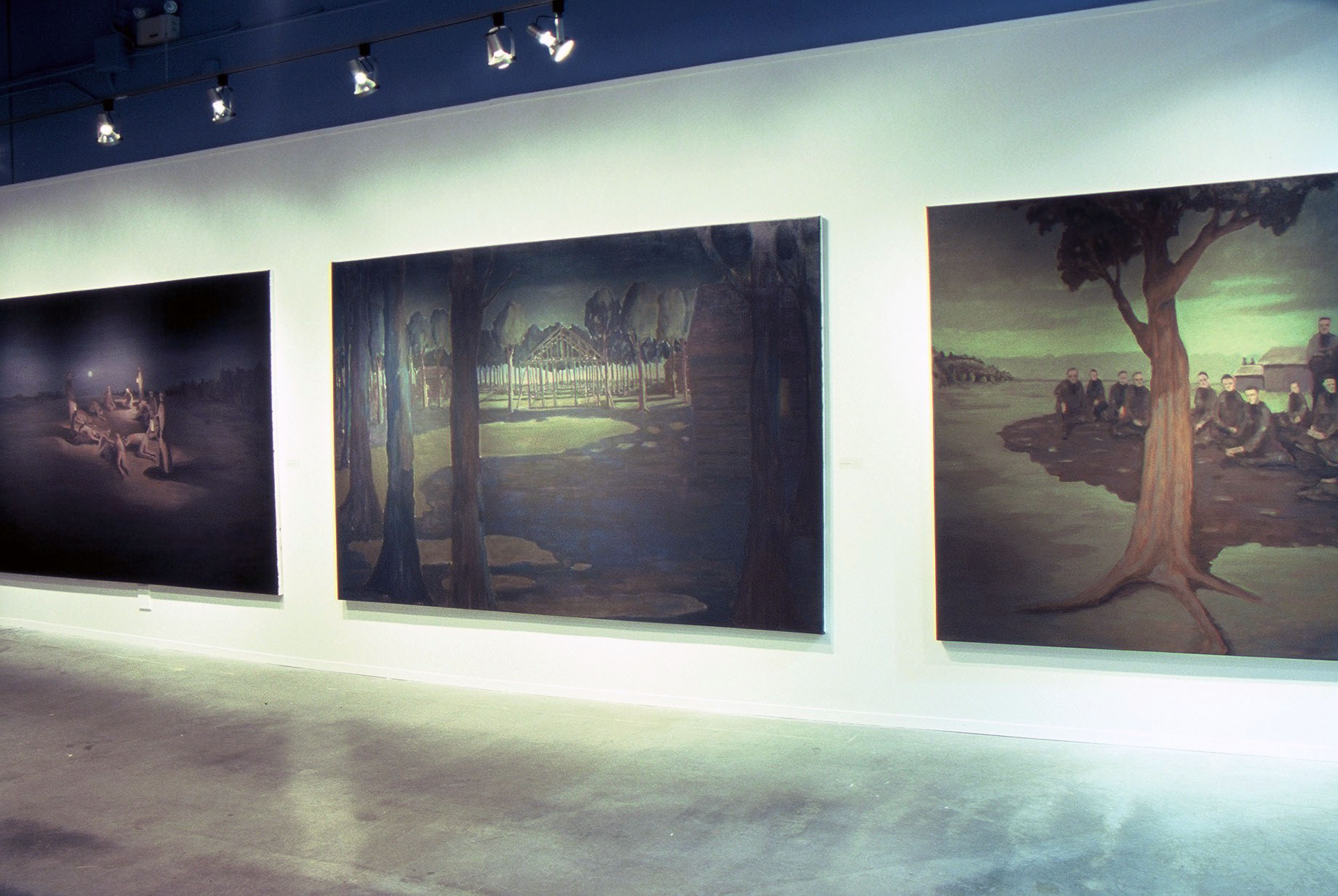
Witness the Culmination
Michael Lewis
September 7 - October 6, 2007





Michael Lewis -- Witness the Culmination
We cannot know what is to come. We can visualize, propose and make assumptions but there is no proof that what we wish for will develop. Utopia represents a vision of the future that is unequivocally imaginary. The word itself literally means ‘no-where’. This makes Utopia ideal and fundamentally virtual. In fact, it must be contended that the existence of utopia is conditional with its virtuality. If it were to be realized it would shift from what is to come, to what is here and now. It would be reality, duration, an unfolding of life rather than a projection, an image or a fantasy. Michael Lewis’s paintings in Witness the Culmination mine this ambiguous phantasm, delineating the intersection between utopian ideas and their implementation.
The large-scale canvases included in the exhibition suggest rural and historical aspects of utopia viewed from an outsider’s perspective. Revealing a discontinuity between social idealism and its communal practice. Lewis’ outlook is plainly skeptical. His paintings are imbued with a sense of immediacy, gravity and weight, suggesting materialism rather than transcendence. Specifically, Lewis presents the brutality, hardship and oppressiveness that often co-habits utopian communities. Far from some paradisiacal hallucination the painter’s imagined social groups are conformist and austere. A palpable sense of isolation removes the viewers and separates them from the internal logic with which the figures in the paintings are engaged. If this is utopia, we are not invited.
Nonetheless, our exclusion or alienation from the scenes promotes a more genealogical consideration of utopia. Particularly, we are prompted to question why utopia remains a steadfast, but poorly defined social obsession. Historically, utopia is a notion intertwined with the Christian mythology of western culture. The phantasmagorical imaginings in the myth of Adam and Eve and the horror stories of Revelation foreground utopian thought, bridging the space between the supposed beginning and end of time. Even dogmatic forms of Marxism, with their visions of an atheist utopia, contain what Zizek refers to in the Fragile Absolute as a “’Messianic’ notion of history”.[1] This kernel is the motivating factor of the utopian dream. It is a belief in the futurem the coming savior and the “final deliverance of the Faithful,” which is the root of idealist fantasy.[2] The cultures, cults, political movements and religious orthodoxies developed around utopia augment and extend its reign, constantly announcing the impending arrival of an inchoate ideal. The specters of hope spring eternal, coupled with the equally eternal forms of waiting, suffering and non-fulfillment.
This waiting for a perpetually imminent Eden manifests in Lewis’s paintings through a sense of intense privacy and near paranoia, emphasizing the hermetic self-reflection of utopian thought. Lewis doubles this inward looking through his painting process. Working directly on the canvas, without sketches or photographs, he converts his memories and recollections into impressions and figurative tableaus. Through this intuitive method his work breaks from the tradition of documentation, maintaining a stubborn subjectivity. Lewis’s emphasis on the subjective subtly draws attention to the fictions surrounding utopia and the power relations performed by individuals within its rigid social hierarchies. Ultimately, Witness the Culmination reveals that communities dedicated to utopianism are at once trapped in solipsism and obsessively anticipating a future that can never be fulfilled.
- Scott Rogers
Sources
[1] The Fragile Absolute - or why is the Christian legacy worth fighting for? Slavoj Zizek, Verso, London, England, 2002. pg.2.
[2] Zizek, p.2.
Biographies
Michael Lewis studied Experimental and New Media at the Ontario College of Art. His work has been exhibited in solo and group shows throughout Canada, including The Art Gallery of Ontario, Toronto, Ontario; Cambridge Galleries, Preston, Ontario; and, Centre d’expositionL’Imagier, Gatineau, Quebec. In addition, his work is in the public collection of the Art Gallery of Ontario andin international private collections. Lewis is the recipient of numerous awards and honours and has accepted grants from the Canada Arts Council, the Ontario Arts Council and the Toronto Arts Council.
Scott Rogers is a multi-disciplinary artist and writer based in Calgary. He has upcoming exhibitions at the University of Lethbridge and Eastern Edge Gallery in St. John’s, Newfoundland.
